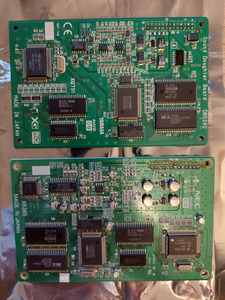Thank you very much for the feedback so far. Replacing bad chosen caps by Creative with better ones makes sense when recapping, I'll have a look at this.
Sometimes you don't have a choice which type of capacitors to use when the space available matters. My AWE32 is populated with wet caps of a small diameter. I haven't found organic polymer caps at Mouser those diameter fits but Nichicon Fine Gold Muse fits (they are thinner and longer).
Talking about space brings me to the next "audio caps" question:
I'm going to recap my NEC XR385 wavetable module, which is a clone of the Yamaha DB50XG. Since it is put piggyback on the sound card the height of the replacement caps plays a big role. When I compare the pictures of both wavetable modules it seems that Yamaha used Tantalum caps. As far as I know their current should either be limited when switching on the PC or their max. used voltage should be derated to 50% of their nominal voltage. The largest 47 µF Tantalum fitting on the NEC board I found on Mouser has 20V. Since they're used for buffering 12V it derates just to 60% and not 50%
Do you think that it is a good idea to use Tantalum caps in this specific case or in audio circuits in general? Should I worry about the caps used on the Yamaha board?
